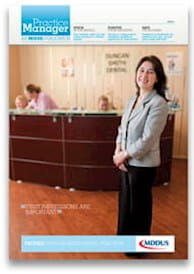ON THE morning I visit the Duncan Smith Dental Practice I find myself wandering up a wide street in the Scottish east coast town of Musselburgh checking my map again to see if I’m in the right place. Soon though I spot a small brass plaque beside a modest entrance tucked between a mortgage centre and a private nursery.
Practice manager Andrea Smith greets me in a bright, sizable reception area just off the street. “Did you manage to find us okay?” she asks and then apologises. The week I have chosen to visit the practice is having large streetfront signage installed to incorporate their new logo.
"First impressions are important," she says later showing me a drawing of how the new signage will look. It soon becomes clear that making and maintaining a good impression is a high priority to Andrea and her practice team.
Certainly on first entering Duncan Smith Dental there’s a TARDIS-like sense of something much bigger on the inside. Andrea tells me there has been a dental practice at the site since 1933 though originally accommodating only one dentist working in a single surgery and small laboratory. Dundee dental graduate Duncan Smith – Andrea’s husband – took over the practice in 1992 and expanded both the team and the office space so that now six dentists, a fulltime hygienist and 12 staff work here.
Just under 7,000 patients attend the practice, most from in and around Musselburgh, which lies six miles from Edinburgh on the River Esk. It is said to be the oldest town in Scotland – dating to Roman times – and is also the site of the world’s oldest golf course and the famous Musselburgh Racecourse. Over the years the population in the area has grown steadily being in a busy commuter belt.
One key factor behind the steady expansion of the dental practice has been its emphasis on quality treatment combined with attention to the whole patient experience and good "customer care". Or as Duncan Smith puts it: "Our aim is to keep the back door closed, if you like, so that once patients join the practice they stay with us for a long time."
Andrea also sees this as crucial in ensuring the continued success of the practice. She says: “It’s important to focus on the whole management of the patient from the moment they first set foot in the practice – making eye contact, being courteous, acknowledging needs. All these things are important in making the patient feel it’s a personal service; that they are not just another number but an individual."
MARKET DRIVEN
This focus on the "patient as customer" is becoming increasingly common among UK dental practices, driven at least in part by the growing number of dentists moving away from the NHS to offer private treatment. In an open marketplace, patients will vote with their feet so finding ways of attracting and keeping them becomes ever more crucial. Given now the emphasis on 'choice' throughout NHS primary care across the UK it’s also something general medical practices may need to pay increasing attention to in coming years.
Attention to the patient experience begins from day one at Duncan Smith Dental, as Andrea explains. Each new patient at the practice is presented with a welcome pack with information leaflets explaining the treatments and services offered. The pack also incorporates a statement of practice aims promising consistency, a relaxed and friendly environment and "our utmost respect at all times".
"I know it may sound like a cliché but we genuinely believe in these aims," says Andrea.
Patients are then given a "walk through" to get familiar with the premises before first meeting the dentist. Most patients will attend the same dentist, even for emergencies, says Andrea. So the stress of seeing someone unfamiliar is taken away.
Every aspect of the patient encounter is considered by Andrea and her staff in seeking to improve service levels. Two staff work reception at all times greeting patients and the practice recently installed a new telephone exchange with four incoming lines to reduce call waiting.
"We run a tight schedule so our waiting area is rarely busy," says Andrea.
To help personalise patient contacts the practice makes use of a pop-facility within the electronic records. Here relevant personal or health details are recorded and displayed whenever a patient’s file is edited. These might include anything from a needle phobia to a recent bereavement. This way staff can be aware of a patient’s particular circumstances.
HOW ARE WE DOING?
To drive improvements in patient–customer care the practice conducts patient surveys on an annual basis. Says Andrea: "We target 15 to 30 patients per dentist across the age-groups. Patients fill out forms in the waiting area. We then collate all the information and it’s displayed in charts and graphs along with all the patients’ comments."
Satisfaction is measured against numerous criteria including waiting times, staff attitude and facilities. The staff then meet to discuss the results and any potential improvements.
"For example, in the questionnaire we did two years ago it came to light that explanations of our costs weren’t good," says Andrea.
"Patients were unsure what they were being charged for when they reached the front desk; it wasn’t explained well. So we positively acted on this and put prompts on the monitor screen to remind us to check patients’ understanding of treatment costs. Since then we’ve greatly improved in this area."
Another recent innovation was the installation of an automated text messaging service to remind patients of upcoming appointments.
"It’s dramatically decreased the number of DNAs we have," says Andrea.
INTERNAL CUSTOMERS
Speaking to Andrea it becomes clear that she is a firm believer in a team approach to improving quality standards in the practice – the notion that staff are in effect "internal customers" that must be equally valued. She explains: "If your staff feels taken care of that naturally reflects in their attitude towards patients. If you have disgruntled staff, patients will pick up on that."
Fostering a team ethos is essential. Recently the practice was awarded membership of the BDA’s Good Practice Scheme – a quality assurance programme demonstrating dental care provided at nationally recognised best practice standards.
"A lot of work went into achieving this and it had to be a team effort," says Duncan Smith. An important result of this was a shared sense of pride and to celebrate the entire staff was treated to a weekend at the Crieff Hydro near Perth.
But at the heart of the team is the partnership between Andrea and Duncan. Andrea never intended becoming a practice manager. She started out her professional career as a veterinary surgeon in a small animal practice and has also worked as a manager in her parents’ retail business.
After marrying Duncan she took time out to look after their three children but as the practice grew and she saw how busy Duncan was it seemed only natural to help out with the business.
"Back then the practice wasn’t computerised and I could see that overdue accounts were getting out of hand. And if there is one thing that annoys me it’s money not coming in, people not paying their accounts."
So she set up an automated accounts system and her role grew from there. She enjoys working with her husband developing the practice.
"We very rarely have any arguments," she says. "Duncan is a bit less accepting of change but once he sees the benefits, he’s fully onboard."
When I ask about the future of the practice the answer is surprising.
"We have no plans for physical expansion," says Duncan. "Our aim is to ensure we offer an increasing diversification of treatments for our patients, with an even greater emphasis on quality dental care."
To this end the practice is keen on improving preventative dentistry and has also expanded into other treatment areas such as cosmetic dentistry and implantology. Most new patients to the practice now come mainly from referrals – friends and family members of existing patients – and this suits Andrea just fine.
"I don’t feel we have to spend a lot of money on advertising because the best advertising is word of mouth."
Jim Killgore is an associate editor of Practice Manager
This page was correct at the time of publication. Any guidance is intended as general guidance for members only. If you are a member and need specific advice relating to your own circumstances, please contact one of our advisers.
Read more from this issue of Practice Manager

Save this article
Save this article to a list of favourite articles which members can access in their account.
Save to library
